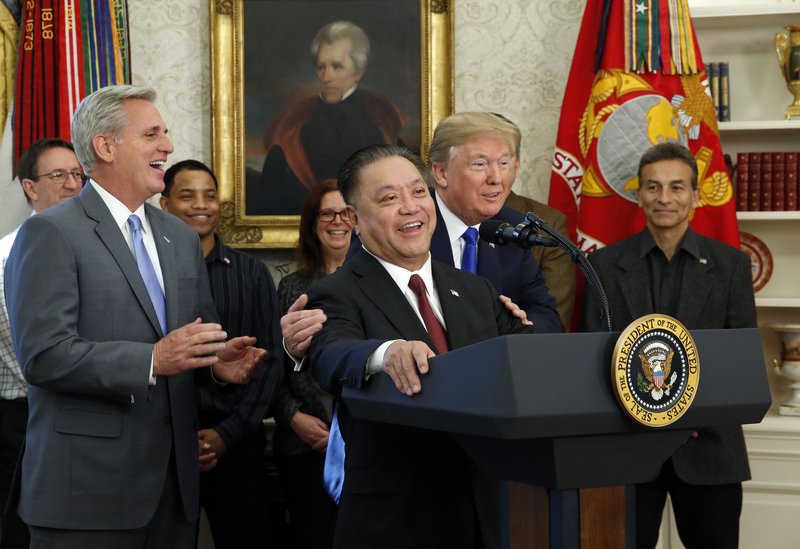这位高管去年的报酬是美国普通上班族的2000倍

|
半导体公司博通(Broadcom)首席执行官陈福阳以1.032亿美元的薪酬成为2017年工资最高的美国大公司CEO。 《华尔街日报》报道,在陈福阳之后分列二、三位的分别是哥伦比亚广播公司(CBS)CEO莱斯·穆维斯(6930万美元)和航空零部件制造商Transdigm掌门人尼古拉斯·哈维(6100万美元)。 2017年陈福阳的基本工资为110万美元,超额完成2017年收入和营业利润率目标为他带来了370万美元的绩效奖金。他的九位数薪酬还包括:往返于公司和宾夕法尼亚州住所产生的差旅费,约为23234美元(博通已在今年4月将总部从新加坡迁至美国加州),公司按401(K)计划为他缴纳的16200美元养老金以及36386美元的出租车费。 不过,博通提交给监管部门的文件显示,陈福阳拿到了9830万美元的公司股票奖励,与之相比上述收入简直不值一提。总之,陈福阳的酬劳达到了1.032亿美元,同比上涨约318%。 仅在数字层面比较,陈福阳的收入是美国普通上班族的2039倍——美国劳工统计局(Bureau of Labor Statistics)的数据显示,后者的薪酬为50620美元。 但情况没有那么简单。上述9830万美元股票酬劳不会马上进入陈福阳的腰包。相反,这些股份将在2020和2021年发放,而且陈福阳能拿到的股票数量还将取决于当年底博通的股价。 举例来说,如果博通跑赢90%的标普500指数成份股,那么到2021年陈福阳就可以获得价值1.792亿美元的股票。但反过来,如果博通的股价落后于75%的标普500指数成份股,陈福阳就拿不到任何股票酬劳。 许多公司都采用了这样的薪酬结构,其作用是长期留住CEO,同时将其收入和公司的经营状况挂钩。这样做的逻辑是,它能更多地促使CEO去改善和发展自己的公司,而不是基于短期效益进行决策。 不过,就算考虑到这一点,我们仍然很难否认CEO和普通上班族的收入差距令人震惊。《华尔街日报》指出,2017年各位CEO的薪酬至少比上年提高了9.7%,而公司员工的平均时薪涨幅为2.9%。 这样的情况屡见不鲜。经济政策研究所(Economic Policy Institute)的研究显示,剔除通胀因素后,1987-2014年CEO的收入上升了997%,远高于普通劳动者10.9%的涨幅。但国会议员和监管部门目前正在为了缩小这个差距而调整税法和报税标准。美国证券交易委员会(The Securities and Exchange Commission)现在要求公司披露薪酬比例,特别是普通员工和CEO的收入差距(博通的2017财年从2016年10月开始,因此不必披露该数据,只有2017财年始于2017年1月1日之后的公司需要披露此项年度数据)。 此外,唐纳德·特朗普总统2017年签署的税收法案废除了一项抵减绩效薪酬税额的规定。此前,CEO绩效酬劳的起税点为100万美元,而且基于绩效的其他所有收入也都免税。按照新法案,美国联邦政府在随后10年里预计将增收93亿美元。 这些变化能否影响CEO薪酬不断上升的趋势仍有待观察。(财富中文网) 译者:Charlie 审稿:夏林 |
The title of highest-paid CEO among the U.S.’s largest companies goes to Broadcom executive Hock Tan, who earned $103.2 million in 2017. The semiconductor company’s CEO beat out second place Les Moonves, CEO of CBS($69.3 million), and third place W. Nicholas Harvey, CEO of aerospace components maker Transdigm’s ($6l million), according to the Wall Street Journal. In 2017, Tan had a base, cash salary of $1.1 million, plus a performance bonus of $3.7 million for exceeding revenue and operating margin targets in the year. Also wrapped into his nine-digit payday: some $23,234 in travel expenses for Tan to travel to his Pennsylvanian residence (Broadcom completed its move from Singapore to California in April), as well as $16,200 in 401(K) employer matching contribution, and another $36,386 for car service. But all of that pales in comparison to the shares Broadcom awarded to Tan that had a value of $98.3 million, according to regulatory filings. All together, Tan earned $103.2 million—about 318% higher than a year earlier. And so on the face of it, Tan earned roughly 2,039 times more than the average U.S. worker, who pulled in $50,620 according to the Bureau of Labor Statistics. Still, it’s not as simple as that. That $98.3 million in stock awards won’t be immediately available to Tan. Instead, those stock awards will vest in 2020 and 2021, while the number of shares Tan will be eligible for will also depend on the value of Broadcom shares at the end of those two periods. For example, if Broadcom shares perform better than 90% of companies in the S&P 500, Tan would be eligible for shares worth $179.2 million by 2021. Though on the flip side, if Broadcom shares perform worse than 75% of S&P 500 companies, Tan will receive no shares. The compensation structure, common in many companies, is used to keep CEOs in their jobs over the long run, while tying their compensation to the company’s health. In doing so, the logic goes, chief executives are more motivated to improve and grow their company rather than making decisions based on the short term. Even when factoring that in, however, it is hard to deny that the gap in pay between CEOs and the average worker is startling. According to the Journal, CEOs received raises of 9.7% or better compared to last year. Average hourly earnings for all U.S. workers, in contrast, rose 2.9%. It’s no new trend. Adjusted for inflation, CEO pay skyrocketed 997% between 1987 and 2014—vastly outpacing the 10.9% gains made by the typical workers, according to a study from the Economic Policy Institute. But lawmakers and regulators are now making changes to tax laws and reporting standards in the hopes of addressing that gap. The Securities and Exchange Commission now requires companies to include pay-ratio disclosures, particularly the difference between median worker pay and that of the chief executive (Broadcom did not have to make that disclosure, as its fiscal 2017 year began in October 2016. Only companies reporting after Jan. 1, 2017 reported the ratio this year). Separately, the tax bill signed in 2017 by President Donald Trump also does away with a tax deduction for performance-based pay. Previously, the first $1 million in executive pay was tax exempt—though any additional pay based on performance was also exempt. Under the new law, the federal government is expected to collect $9.3 billion more over a 10-year period. Whether these changes will have an impact the trend of ever-rising CEO pay remains to be seen. |













